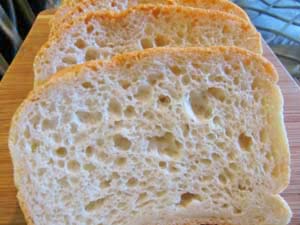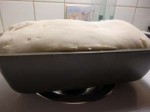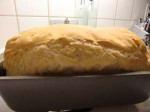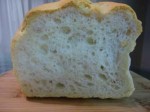A couple of days ago I made my first attempt at making a copycat recipe for an Udi’s-style gluten free white bread recipe. It was a flop. Today I took another stab at it and created a decent gluten free white bread recipe! Yeah! It’s not perfected yet but still tasted wonderful, even after it cooled. I used many of the ingredients which Udi’s white bread contains, however, the rice flour is just a little grainy. You can’t notice it in a sandwich, but you can notice it a little when eating it plain. I’d really rather use sorghum flour instead of rice flours, but just had to give this a go. Meanwhile, the texture of this bread is wonderful! -similar to sourdough sliced bread. It has that Udi’s chew, yet soft. And this recipe makes a much larger loaf than Udi’s white sandwich bread. I also added some substitutes for corn-free dieters. Enjoy my gluten free white bread recipe!
It had just a tad too much moisture, evidenced by the slight sinking in of the bottom (mostly) and a little on one side of the loaf. You can see the built-up condensation in the photo above at the bottom of the loaf. It only occurred after removing from the oven. And once I sliced the ends off to allow the steam to escape, it stopped sinking in So I reduced the water by 2 tablespoons in the recipe below. I’ll give it another go and see if it needs to reduce further and will keep you posted.
As in all gluten-free bread just warm it up a bit once it begins to stale to get it back to that fresh feel. This can be achieved by either microwaving on a low temperature or by heating a moistened paper towel in the microwave on high and laying it on top of the bread on your countertop.
I tried to keep this recipe as natural as possible. I did not use Expandex, though I was tempted. However, rice flour and starches make a fluffy texture all by themselves. Stay tuned in for updates as I continue to experiment to get rid of that slightly gritty texture. I’m thinking I’ll most likely reduce the brown rice flour in this gluten free white bread recipe to 1/2 cup and then increase one of the starches. I also will play around with the amount of water; possibly lessen the vinegar, and try beating it at a slower speed. Sometimes when the holes in the bread are too large it keeps the moisture (steam) locked in those holes and that can also create the sinking. I’ll add my updates at the bottom of this page and announce that I tried something new on Twitter and Facebook.
UPDATE – September 14, 2012: Though I haven’t made this recipe lately, I’ve learned that though the outside may be brown enough, the inside still needs additional baking. Therefore, I have updated the baking time from 35 minutes to 45 minutes. That should do the trick, though I haven’t tried it myself. Once it has reached the desired browning cover with foil and continue to bake. This recipe as is should work well with additional baking time. I think I’ll make again soon and use an additional egg white. I’ve had much success with using 4 egg whites lately.
You may read the Udi’s Gluten Free White Sandwich Bread ingredients [their white bread ingredients has changed.
As of January 21, 2018, see Udi’s White Bread ingredients including Modified Tapioca Starch, Modified Cellulose, and Cultured Brown Rice, all highly refined ingredients.
As of January 11, 2020, the overly high-processed ingredients only include modified food starch and maltodextrin.

A copycat recipe of Udi's While Bread (Original). The perfect texture for sandwiches, without additives.
Ingredients:
- ¾ cup filtered water, warmed to 110°F
- 1 Tablespoon evaporated cane juice (or sugar)
- 1 Tablespoon gluten free brown rice syrup (Lunbderg's)
- 1 packet or 2 ¼ teaspoons gluten-free instant dry yeast (SAF and Red Star are gluten-free)
- 3 egg whites, at room temperature
- 1 teaspoon apple cider vinegar
- ¼ cup extra virgin olive oil (or grape seed oil)
- 2 cups tapioca starch
- ½ cup brown rice flour
- ½ cup potato starch
- 2 teaspoons xanthan gum*
- ¾ teaspoon salt or fine sea salt
- ½ teaspoon baking powder
Instructions:
- Grease or spray oil a 9×5-inch silver metal loaf pan (not black inside, because silver reflects heat and black absorbs heat).
- Preheat oven to 170 – 200°F (lowest possible).
- Add syrup and sugar to warm water and stir; add yeast and stir again. Use a large enough cup, as it may bubble over; set aside until foamy on the top, at least 5 minutes, or until you have completed mixing the dry ingredients.
- Beat the egg whites on high speed in a large mixing bowl until foamy, not yet at soft peaks.
- Whisk together the dry ingredients; set aside.
- Add the oil, vinegar and yeast mixture to the egg whites and blend on low for a short time.
- Add dry ingredients all at once and mix on low speed until all dry ingredients are moistened. Then beat on high for 1 minute on high.
- Add dough batter to prepared pan and distribute and smooth the top with a little cold or room temperature water using a rubber spatula. You'll want to meet all sides of the pan. If you miss the corners that will be okay. It will fill in upon rising.
- Turn oven off. Leave it open for about 30 seconds to bring down the temperature a bit. Place the bread pan in the oven. Close the oven door and allow the dough to rise until it has risen 1" over the top of the pan, about 30 minutes. If you see any cracks in the top of the bread that is your cue to remove it from the oven.
- Remove pan from oven and preheat oven to 350°F.
- Place the pan on the center of the rack in the center of the oven and bake for about 45 minutes.
- Remove the loaf from the oven and immediately remove it from the pan (careful it will be hot). If you do not remove it right away the steam will make the crust soggy.
- Slice the ends off so that the steam will be allowed to escape. Set the loaf on its side on a cooling rack to cool completely, at least an hour. If you slice it too soon, it will bunch up and appear smaller and not uniform.
- Slice with an electric slicer, electric knife or serrated knife.
Tips
If you are not sure if your baking powder is fresh, just place a little bit in some warm water. If you hear it sizzling then it's still fresh. If not, discard it.
* Corn-free dieters should only use corn-free xanthan gum in this gluten-free white bread recipe or substitute with guar gum (I haven't tried this, though); and use a corn-free baking powder. One brand of corn-free baking powder is Hain Featherweight. Featherweight is gluten-free, corn-free and sodium-free. It contains monocalcium phosphate, potato starch, potassium bicarbonate. Or you can make your own. See recipe for Corn-Free Baking Powder Recipe.
Latest recipe version pics:






This recipe is FANTASTIC. Thank you. THANK YOU!
hi carla
i have done of your gluten free breads, i just can’t seem to get the rise i’m looking for, could it be the fleischmanns instant yeast or bread machine yeast they tell me they are the same, here in Ontario Canada i cant get red star yeast or SAF yeast, trying Bob’s mill bread in the pkg with SAF yeast i got a wonderful bread done in breadmachine>>the rise was nice, all of my gluten free flour are bought in “bulk barn” store perhaps all the gluten free flour is getting to old,or the yeast or my tap water>>> at this expense i just feel like giving up,
thank you
Hi Diane,
I’m not sure what you’re saying here, “i have done of your gluten free breads”, but I assume you either mean you’ve made some of my gluten free bread recipes, or you haven’t.
I use SAF instant yeast. If become foamy when proofing (mixing yeast, warm liquid and sugar of some sort together), the yeast you are using is fine. When not using instant yeast or a similar quick rising yeast, it will just take longer to rise.
In many of my earlier recipes I only used 3 cups of flour and starches. This may be okay in a 9 x 4-inch loaf pan, but if you’re looking for a higher rise in a 9 x 5-inch pan, perhaps increase the ingredients by 1/2 cup. If the bread is caving in on the sides upon cooling then do not add additional liquid. Otherwise do so. Also include additional xanthan or guar gum, salt, etc.
If your bread is rising fine, but then shrinks, it means it not baked long enough. Perhaps my free ebook would be of some assistance to you. You may download it at http://glutenfreerecipebox.com/wp-content/uploads/2012/06/gfbbd_cover.jpg . It doesn’t list everything I know about gluten free bread baking, and I have learned more since I have written it. It should give you a good start, though.
I hope this helps!
Carla
Why do you just use egg whites?
Hi Jana,
I use egg whites in my gluten free bread recipes to provide a pliable texture. Hope this helps.
Carla
Facebook Comment:
“Tastes great :))”
~F.S.C.
Wonder how this would be to substitute regular rice flour with sweet rice flour???
Lori, I’ve tried superfine white rice flour in one of my gluten free bread recipes and it turned out way too starchy. You may find more success in using sweet rice flour. And because it caved in on the sides, that means it had too much liquid. Therefore, you wouldn’t have to adjust the liquid in this recipe, as you normally would need to do when using sweet rice flour as a sub (it is a bit finer). Good luck!
Carla
Have you tried to make this w/ sorghum? I’m guessing that you would use it to replace the rice flour? I am very tired of the texture of rice based GF breads.
Hi KE!
I haven’t tried using sorghum in the recipe. I have, though in this one: http://glutenfreerecipebox.com/gluten-free-bread-recipe-oat-sorghum It’s a video of me using gluten-free oat flour, but see the link for the recipe. You can use either. And it comes out lighter with sorghum.
Carla
I use King Arthur gluten free flours so how much and what do I leave out of the recipe when I use this. Also Red Mill has an all purpose flour.
Hi Jackie, if you’re using King Arthur’s multi-purpose flour, just skip the flours and starches. I haven’t used it myself. Good luck, and I hope you enjoy it!
So…I attempted this bread, which appeared simple enough (compared to some other recipes I have tried)….the yeast proofed well. I have to ask what type of mixer you use to mix this “batter”. It rose up the beaters on the stand mixer and started flying all over. I switched to a hand mixer and it was even worse. Once I did get it mixed and let it rise – I did not get the “one inch over the top of the pan” (pan was the dimensions you state) before the top started cracking. I baked it, cut of the ends and the whole thing condensed itself and became about 2 inches tall, very dense and “chewy” inside. NOT AT ALL, light and airy like yours in the photos.
I so want to figure our what the issue is!!! I believe the mixing was the major problem. All my ingredients are fresh and the yeast proofed well. PLEASE give me some suggestions on how to “get it right” the next time! I SOOooo wanted a chicken salad sandwich on this bread, but alas – it was not to be!
Thanks in advance for you help and guidance.
Kelly,
It sounds like the mixing was the problem. I use a KitchenAid mixer. They come in different power levels. I believe the model that I have has a 350 watt motor. KitchenAids are wonderful, and really can make a huge difference in some recipes. The only other things I can think of is whether you packed the flour/starches too much when measuring. It is always best to use individual measuring cups by spooning the flour into them and leveling off with the handle of the spoon; or whether your baking powder was any good. Of course, an error in measuring is always a possibility. Chefs use what is called “Mise en Place”, which means they measure everything, individually, prior to baking/cooking. This prevents many errors.
The only reason I suggest cutting off the ends, is when it rises too much. It helps allow the steam to escape to prevent falling. In your case, it sounds like it did not need the ends cut off. I hope this helps somewhat, Kelly!
Carla
Thanks for the advice/response Carla. I do measure via the “spoon” in method and did test my baking powder prior to use as you suggested. I “think” the issue was the mixing. THANKS Again!!! :-)
My son can’t have potato starch. Can I use arrowroot starch instead and how much? Would I still use the 2 cups tapioca starch as well?Thanks
Hi Shelley,
You can substitute the potato starch with cornstarch. Bob’s Red Mill brand is GMO-free. Arrowroot may work, as well. I have not used it much yet, but find it to be heavier than other gluten-free starches. Perhaps it just requires more liquid. I’m really not sure. The recipe calls for 1 3/4 cups tapioca starch. I would use the same amount and just see how it goes. If anything goes wrong with the bread during baking or cooling, just let me know and we can work together to fix it. Good luck!
Do you have suggestions for making this in a bread machine?
Thank you!!
I haven’t had any luck making bread in a machine, without adding time to the prep work. I’ve had to help the dough along throughout the kneading process, as it gets stuck to the sides. This recipe is more of a batter and would not work in a bread machine at all. It’s really fast to do by hand, though. Give it a try!
Facebook comment:
“OMG ! Did this bread yesterday… Easy and Amazing ! : ) Thank you so much”
~ SLG
Thanks Carla! :-) I love seeing another gf bread option, esp. one similar to Udi’s. will give this a try. Personally, I like having a bread recipe option without sorghum…I’ve had countless reactions to american grown sorghum, so I don’t use it anymore. :-( I was sad to leave it behind, as I love the flavor & texture it added to my baked goods.
Faydra, You are very welcome! I understand about not using sorghum flour. Many people have trouble with gluten-free whole grains. Hope this works out for you. The high moisture or the steam is the main problem with this recipe. I may try reducing all ingredients and baking it in a 9×4″ loaf pan. We’ll see. There’s lots of things to try, even the use of superfine brown rice flour, but I’ll need to increase the water quite a bit. Let us all know how this recipe turns out for you!